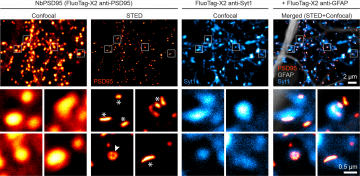FluoTag®-X2 anti-PSD95
400,00 €
A fluorophore-conjugated single-domain antibody that specifically recognizes mouse and rat PSD95.
FluoTag®-X2 anti-PSD95 is derived from an in-house developed single-domain antibody (sdAb) that specifically recognizes a PSD95 (Postsynaptic Density Protein 95). PSD95 (alternative names: PSD-95, SAP-90 and DLG4) is a member of the MAGUK family, and it plays an essential role in forming a dynamic scaffold at the post-synapses. It functions as an organizing centrum of receptors, ion channels, kinases, and other relevant players in achieving synaptic plasticity and molecular changes during long-term potentiation.
Our nanobody binds selectively and strongly to one of the PDZ domains of PSD95, and it does not bind to either of its close family members, PSD93 or SAP102.
FluoTag®-X2 anti-PSD95 is directly conjugated to two fluorophores per sdAb (FluoTag®-X2 variant). To learn more about the FluoTags®, please visit our Technology section here.
| Variations: |
|
||||||||||||||||||||||||
|---|---|---|---|---|---|---|---|---|---|---|---|---|---|---|---|---|---|---|---|---|---|---|---|---|---|
| Related Products: | - | ||||||||||||||||||||||||
| Clone: | 1B2 | ||||||||||||||||||||||||
| Host: | Alpaca | ||||||||||||||||||||||||
| Produced in: | E.coli | ||||||||||||||||||||||||
| Application: | IF, IHC | ||||||||||||||||||||||||
| Dilution: | 1:500 (corresponding to 5 nM final concentration) , 5 µg/mL (IHC) | ||||||||||||||||||||||||
| Capacity: | N/A | ||||||||||||||||||||||||
| Antigen: | - | ||||||||||||||||||||||||
| Targets: | PSD95 | ||||||||||||||||||||||||
| Specificity: | Recognizes mouse and rat PSD95 (other species not tested). It does not cross-react with PSD93, SAP97 or SAP102. | ||||||||||||||||||||||||
| Formulation: | The single sdAb clone was lyophilized from PBS pH 7.4 containing 2% BSA (US-Origin). For more details, click the "Protocols" button above and check "Reconstitution and Storage". | ||||||||||||||||||||||||
| kDa: | - | ||||||||||||||||||||||||
| Ext Coef: | - | ||||||||||||||||||||||||
| Shipping: | Ambient temperature | ||||||||||||||||||||||||
| Storing: | Vials containing lyophilized reagent can be stored at 2-8°C for up to 12 months. After reconstitution, store at -80°C for up to 6 months. Working aliquots can be stored at -20°C for up to 4 weeks. For more details, click the "Protocols" button above and check "Reconstitution and Storage". | ||||||||||||||||||||||||
| Protocols: |
Relevant protocols can be found under the “Protocols” button above. For additional information, visit our Resources page. |
||||||||||||||||||||||||
| References: |
|
||||||||||||||||||||||||
| Notice: | To be used in vitro/ for research only. Non-toxic, non-hazardous, non-infectious. | ||||||||||||||||||||||||
| Legal terms: | By purchasing this product you agree to our general terms and conditions. |








